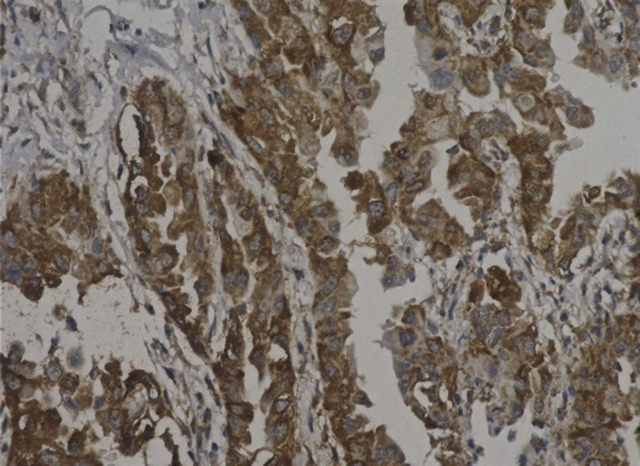IL-34: a new, possible target to tackle drug-resistant cancer cells

Expression of IL-34 (brown) in human primary lung adenocarcinoma tissue. IL-34 expression correlated with poor prognosis in cancer patients and was found to enhance local immunosuppression by tumor-associated macrophages, and also provides cancer cells with a critical survival signal to overcome chemotherapeutic conditions. (Baghdadi M. et. al., Sep 30, 2016, Cancer Research)
Chemotherapy is one of the most important treatments for many cancer patients. In recent years, chemotherapies that target the immune system have been developed, resulting in remarkable advances in cancer treatments. However, the ability of tumor cells to escape immune destruction and acquire resistance to chemotherapy remain major obstacles to effective cancer therapy.
It is known that immunosuppressive macrophages accumulate at tumor sites where the tumor cells have become resistant to chemotherapy. Assistant Professor Muhammad Baghdadi, Lecturer Haruka Wada and Professor Ken-ichiro Seino of the Division of Immunobiology at Hokkaido University’s Institute for Genetic Medicine, conducted research with collaborators based on a theory that chemoresistant tumor cells produce an unidentified substance that increases tumor-associated macrophages, thus enhancing their resistance to chemotherapy.
In the latest research, the team cultivated chemosensitive A549-DS, made from A549 lung cancer cells, together with the chemotherapeutic drug doxorubicin, to create doxorubicin-resistant A549-DR. The researchers examined the two cells, finding a large amount of IL-34 was produced in the A549-DR, but not in the A549-DS.
They also found that the IL-34 produced by A549-DR contributed to the production of immunosuppressive macrophages. Furthermore, their experiment showed that IL-34 enhanced the chemoresistance of A549-DR.
In experiments using mice, researchers found that A549-DR was resistant to the chemotherapeutic drug when transplanted in mice, while A549-DR with depleted IL-34 became sensitive to the same drug, suggesting that IL-34 enhanced chemoresistance in the animal body.
Furthermore, researchers discovered high levels of IL-34 in tumors removed from several lung cancer patients. They also examined the prognoses of post-operative patients—studying those with, and those without IL-34 in their tumors, finding that the former’s prognoses were poorer than the latter’s.
“Currently, there are only a few options to treat chemoresistant tumors.,” Professor Seino said. “This latest finding could make it possible to develop a new therapy, which targets IL-34, to treat chemoresistant cancer cells”.
The research was jointly conducted with Kanagawa Cancer Center, Shiga University of Medical Science, and the University of Tokyo.
Contacts:
Professor Ken-ichiro Seino
Division of Immunobiology, Institute for Genetic Medicine
Hokkaido University
seino[at]igm.hokudai.ac.jp
Naoki Namba (Media Officer)
Global Relations Office
Office of International Affairs
Hokkaido University
pr[at]oia.hokudai.ac.jp>
Associated links
Journal information
Baghdadi M. et. al., Chemotherapy-induced IL-34 enhances immunosuppression by tumor-associated macrophages and mediates survival of chemoresistant lung cancer cells. Sep 30, 2016, Cancer Research. DOI: 10.1158/0008-5472
http://cancerres.aacrjournals.org/content/early/2016/09/29/0008-5472.CAN-16-1170
Media Contact
All latest news from the category: Life Sciences and Chemistry
Articles and reports from the Life Sciences and chemistry area deal with applied and basic research into modern biology, chemistry and human medicine.
Valuable information can be found on a range of life sciences fields including bacteriology, biochemistry, bionics, bioinformatics, biophysics, biotechnology, genetics, geobotany, human biology, marine biology, microbiology, molecular biology, cellular biology, zoology, bioinorganic chemistry, microchemistry and environmental chemistry.
Newest articles

NASA: Mystery of life’s handedness deepens
The mystery of why life uses molecules with specific orientations has deepened with a NASA-funded discovery that RNA — a key molecule thought to have potentially held the instructions for…

What are the effects of historic lithium mining on water quality?
Study reveals low levels of common contaminants but high levels of other elements in waters associated with an abandoned lithium mine. Lithium ore and mining waste from a historic lithium…

Quantum-inspired design boosts efficiency of heat-to-electricity conversion
Rice engineers take unconventional route to improving thermophotovoltaic systems. Researchers at Rice University have found a new way to improve a key element of thermophotovoltaic (TPV) systems, which convert heat…



